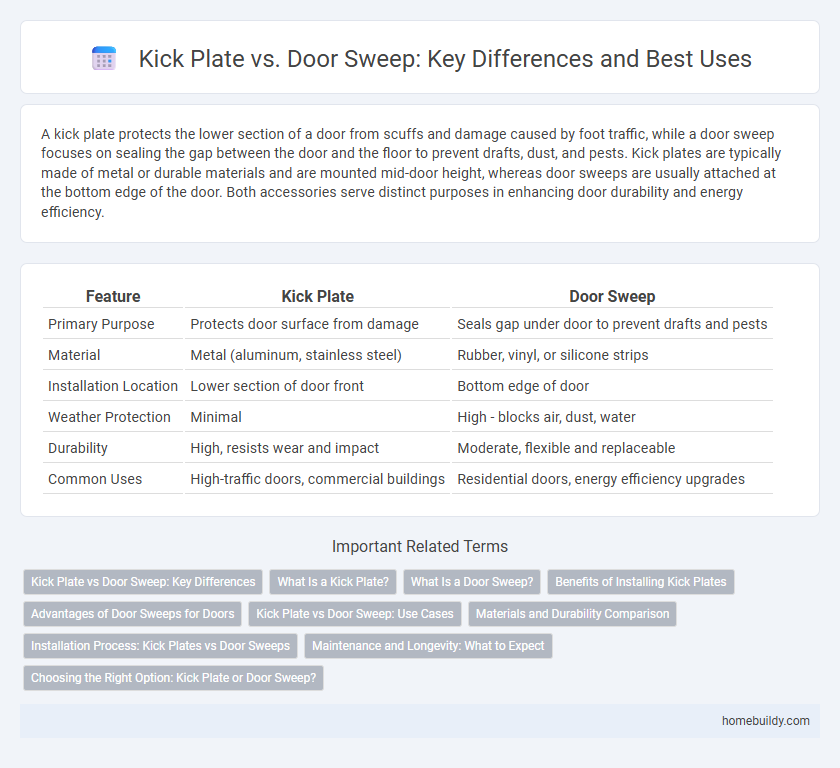A kick plate protects the lower section of a door from scuffs and damage caused by foot traffic, while a door sweep focuses on sealing the gap between the door and the floor to prevent drafts, dust, and pests. Kick plates are typically made of metal or durable materials and are mounted mid-door height, whereas door sweeps are usually attached at the bottom edge of the door. Both accessories serve distinct purposes in enhancing door durability and energy efficiency.
Table of Comparison
| Feature | Kick Plate | Door Sweep |
|---|---|---|
| Primary Purpose | Protects door surface from damage | Seals gap under door to prevent drafts and pests |
| Material | Metal (aluminum, stainless steel) | Rubber, vinyl, or silicone strips |
| Installation Location | Lower section of door front | Bottom edge of door |
| Weather Protection | Minimal | High - blocks air, dust, water |
| Durability | High, resists wear and impact | Moderate, flexible and replaceable |
| Common Uses | High-traffic doors, commercial buildings | Residential doors, energy efficiency upgrades |
Kick Plate vs Door Sweep: Key Differences
Kick plates and door sweeps serve distinct purposes in door protection and sealing; kick plates safeguard the lower part of a door from physical damage caused by foot traffic, while door sweeps provide a seal at the bottom edge to block drafts, dust, and insects. Kick plates are typically made of metal and mounted directly onto the door surface, enhancing durability, whereas door sweeps are attached to the door's bottom and feature flexible materials like rubber or vinyl for effective sealing. Choosing between a kick plate and a door sweep depends on the primary need--impact protection versus environmental sealing--making these components complementary rather than interchangeable.
What Is a Kick Plate?
A kick plate is a protective metal or plastic sheet installed at the bottom of a door to prevent damage from foot traffic, carts, or other impacts. Unlike a door sweep, which seals gaps to block drafts, dirt, and pests, a kick plate primarily guards against physical wear and tear. Common materials for kick plates include stainless steel, aluminum, and vinyl, chosen for durability and ease of maintenance.
What Is a Door Sweep?
A door sweep is a narrow strip of material installed along the bottom edge of a door to seal gaps, preventing drafts, dust, insects, and moisture from entering a room. Unlike kick plates, which protect the lower portion of a door from physical damage caused by foot traffic or equipment, door sweeps primarily focus on enhancing energy efficiency and maintaining indoor air quality by blocking airflow. Door sweeps come in various materials such as rubber, vinyl, or silicone, and are essential for weatherproofing and improving insulation in residential and commercial buildings.
Benefits of Installing Kick Plates
Kick plates protect doors from scratches, dents, and scuff marks caused by foot traffic, extending the lifespan of the door surface. Unlike door sweeps, which primarily seal gaps to block drafts and pests, kick plates provide durable physical reinforcement against daily wear in high-traffic areas. Installing kick plates reduces maintenance costs and preserves aesthetic appeal, making them an essential component in commercial and residential door protection.
Advantages of Door Sweeps for Doors
Door sweeps provide superior protection against drafts, dust, and insects by sealing the bottom gap of doors, enhancing energy efficiency and indoor comfort. They are compatible with a wide range of door types and materials, offering easy installation without altering door aesthetics. Unlike kick plates, door sweeps prevent air and moisture infiltration, contributing to better insulation and reduced utility costs.
Kick Plate vs Door Sweep: Use Cases
Kick plates protect the bottom portion of doors from damage caused by foot traffic, making them ideal for high-traffic commercial or residential entrances. Door sweeps are designed to seal gaps between the door and floor, preventing drafts, dust, and pests, which is essential for energy efficiency and indoor air quality. Choosing between a kick plate and door sweep depends on whether the primary need is physical door protection or environmental sealing.
Materials and Durability Comparison
Kick plates are typically made from durable materials like stainless steel, aluminum, or brass, offering excellent resistance to impacts and scratches, making them ideal for high-traffic areas. Door sweeps, often crafted from rubber, vinyl, or silicone, focus on sealing gaps and preventing drafts, though their materials generally wear faster due to constant contact with floors. In terms of durability, kick plates provide long-lasting surface protection on doors, whereas door sweeps require more frequent replacement to maintain their sealing effectiveness.
Installation Process: Kick Plates vs Door Sweeps
Kick plates are installed by fastening a metal or plastic plate directly to the lower portion of a door using screws, providing a durable shield against impacts and scuffs. Door sweeps attach to the bottom edge of a door, typically using screws or adhesive, creating a seal that blocks drafts, dust, and insects. The installation of kick plates generally requires precise screw placement on the door surface, while door sweeps demand accurate alignment to ensure effective sealing along the floor.
Maintenance and Longevity: What to Expect
Kick plates offer durable protection against scuffs and impacts, requiring minimal maintenance due to their sturdy materials like stainless steel or aluminum. Door sweeps primarily prevent drafts and debris, but their rubber or bristle components may wear out faster, demanding more frequent replacement. Expect kick plates to provide long-lasting resilience with occasional cleaning, while door sweeps need ongoing inspection to maintain effectiveness and extend their service life.
Choosing the Right Option: Kick Plate or Door Sweep?
Kick plates provide robust protection against damage to the lower section of doors, ideal for high-traffic areas where impact resistance is crucial. Door sweeps enhance energy efficiency by sealing gaps at the door bottom, preventing drafts, dust, and pest entry. Selecting between a kick plate or door sweep depends on whether door protection or insulation and sealing is the primary concern.
Kick plate vs Door sweep Infographic

 homebuildy.com
homebuildy.com